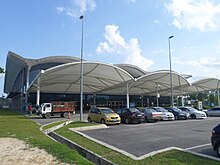|
Iskandar Malaysia
Iskandar Malaysia (Jawi: إسکندر مليسيا), formerly known as Iskandar Development Region (IDR; Malay: Wilayah Pembangunan Iskandar; Jawi: ولايه ڤمباڠونن اسكندر) and South Johor Economic Region (SJER; Malay: Wilayah Ekonomi Johor Selatan; Jawi: ولايه ايكونومي جوهر سلاتن), is the main southern development corridor in Johor, Malaysia. It was established on 8 November 2006.[1] HistoryThe investment corridor of Iskandar Malaysia (IM)[2] grew out of a 2005 government requested feasibility study by the Khazanah Nasional which found that the development of such a zone would be economically, socially and developmentally beneficial.[3] The National SJER Planning Committee (NSPC), hearing Khazanah's findings, put it in charge of developing a sustainable, holistic approach to development in the region.[3] IM was singled out as among the high-impact developments of the Ninth Malaysia Plan, put into action by the then Prime Minister of Malaysia (Abdullah Ahmad Badawi) in March 2006 to cover the period of 2006 to 2010.[4] In November 2006, the Prime Minister, Chief Minister of Johor, Abdul Ghani Othman and Khazanah revealed the Comprehensive Development Plan (CDP).[citation needed] In 2007, the Malaysia-Singapore Joint Ministerial Committee for Iskandar Malaysia (JMCIM) was established to meet annually and review cooperation and developments in IM.[5] During the 16th meeting of the JMCIM on 14 July 2023, it was announced that a task force, led by the Ministry of Trade & Industry from Singapore and Ministry of Economy from Malaysia, would be formed to study the feasibility of setting up a Special Economic Zone (SEZ).[5] Representatives of the two countries signed a Memorandum Of Understanding (MOU) on the SEZ on 11 January 2024.[6][7] AreaThe development region encompasses an area of 2,300 km2 covering Johor Bahru District, Kulai District and part of Pontian District. 5 local government authorities have jurisdiction over the covered area, including Johor Bahru City Council, Iskandar Puteri City Council, Pasir Gudang City Council, Kulai Municipal Council, Pontian Municipal Council. The population of Iskandar Malaysia is slightly over 2 million in 2020. Population by local government areaThe population table is based on the official census of 2020 for the local government areas within Iskandar Malaysia.
Major projects 2006-2025
TransportationAir The region is served by Senai International Airport which is located in Senai.[8] Six airlines, AirAsia, Firefly, Malaysia Airlines, Malindo Air, Jin Air and Xpress Air, provide flights internationally and domestically.[9] Train The region consists of Johor Bahru Sentral, Kempas Baru and Kulai Station.[10][11] Sea For cargo ports, the region consists of Johor Port in Pasir Gudang, Port of Tanjung Pelepas in Iskandar Puteri and Port of Tanjung Langsat in Pasir Gudang. For passenger service boats, the region consists of Johor Bahru International Ferry Terminal in Stulang, Johor Bahru, Kukup International Ferry Terminal in Kukup, Pontian District, Pasir Gudang Ferry Terminal in Pasir Gudang and Puteri Harbour International Ferry Terminal in Kota Iskandar, Iskandar Puteri.[8] Road Iskandar Puteri houses Gelang Patah, GP Sentral, Kota Iskandar, Taman U, Taman Ungku Tun Aminah terminals. Johor Bahru houses JB Sentral, Larkin Sentral, Taman Johor Jaya and Ulu Tiram terminals. Kulai houses Kulai Terminal. Pasir Gudang houses Masai and Pasir Gudang terminal. Pontian houses Pontian Public Transportation Terminal.[12] Grab operates in the city.[13] The internal roads linking different parts of the region are mostly federal roads constructed and maintained by Malaysian Public Works Department. The five major highways linking the Johor Bahru Central Business District to outlying suburbs are Tebrau Highway and Johor Bahru Eastern Dispersal Link Expressway in the northeast, Skudai Highway in the northwest, Iskandar Coastal Highway in the west, and Johor Bahru East Coast Highway in the east.[14] Pasir Gudang Highway and the connecting Johor Bahru Parkway cross Tebrau Highway and Skudai Highway, which serve as the middle ring road of the metropolitan area. The Johor Bahru Inner Ring Road aids in controlling traffic around the city center of Johor Bahru.[14] Access to the national expressway is provided through the North–South Expressway and the Senai–Desaru Expressway. The Johor–Singapore Causeway links the city to Woodlands, Singapore with a six-lane road and a railway line terminating at the Southern Integrated Gateway.[14] The Malaysia–Singapore Second Link, located west of the metropolitan area, was constructed in 1997 to alleviate congestion on the Causeway. It is linked directly to the Second Link Expressway, Johor Bahru Parkway, the railway station, and the North–South Expressway.[8] Further expansion of other major highways in the city were currently ie process.[15] Iskandar Malaysia Bus Service (BIM) was a joint venture between the Johor State Government and the Iskandar Malaysia Public Transport Corporation (PAIM), under the supervision of the Iskandar Regional Development Authority (IRDA) that operated 16 routes in 2014.[16]
See also
References
|
||||||||||||||||||||||||||||||||||||||||||||||||||||||||||||||||||||||||||||||||||||||||||||||||||||||||||||||||||






